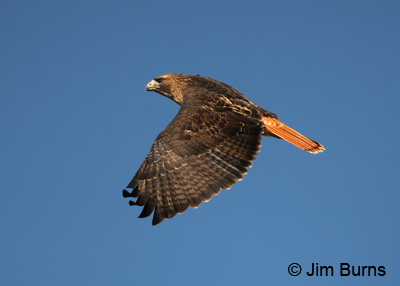
Conventional wisdom holds that early October is the peak of southbound raptor migration through Arizona. I know we are a little late. Evidence came yesterday at a different site in central Arizona where a friend once recorded 74 raptors in a single day, yet we saw only 14, two of them Golden Eagles flying north, probably locals rather than migrants. Today on another typical magic day of fall in Arizona--warm days, cool nights, perfect blue skies--we are destined to see only six. But that is alright here on Aztec Peak where the setting, the views, and autumn's radiant raiment conspire to make the hawk watching almost incidental.
Terrain and weather, in that order, are everything to southbound raptors. Conserving energy, as all but one of an intelligent creator's creatures have evolved to do, migrating raptors will follow coastlines and ridgelines where rising midday thermals afford them easy passage, soaring without constant wingbeats. And they will stack up and sit out the inclement weather and contrary winds of a cold front. At the country's premier hawk watch sites, Cape May in New Jersey, Hawk Mountain in Pennsylvania, Hawk Ridge in Minnesota, migrating raptors are funneled by wind, water, and mountains over high, open points where official counters have wide open visual access. One day last September a friend and I were on Hawk Ridge when 15,000(!) Broad-winged Hawks passed over.
In Arizona there are few if any of these natural funnel points, and there is only one official (manned by trained and experienced hawk spotters) hawk watch. It takes place at Lipan Point on the South Rim of the Grand Canyon, but even there the southbound birds are scattered along the broad front of the north facing rim. The best chance for your personal, productive fall hawk watch in Arizona is to find a peak near the south end of a north/south mountain range, on the day after a cold front, with strong northeast or easterly winds which will push the birds up against the east face of the range.
Over the years I've tried Miller Peak and Montezuma Pass at the south end of the Huachucas, Kitt Peak observatory west of Tucson, and Pinal Peak south of Globe, all with mixed results. Aztec Peak, home to a fire lookout at the end of the Workman Creek Road running east from SR 288 between Globe and Young, holds great potential. It rises to 7700 feet at the south end of the Sierra Anchas, it has a nearly 360 degree view, and its unobstructed east side overlooks the spectacular walls of the aptly named Canyon Creek. Try late September/early October for the hawks. Then go again in late October/early November for the foliage. You won't regret making two trips in six weeks to one of Arizona's very special places.